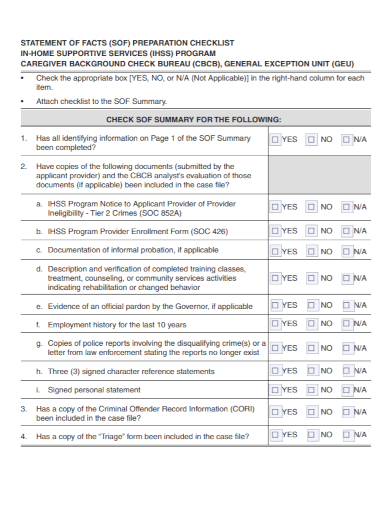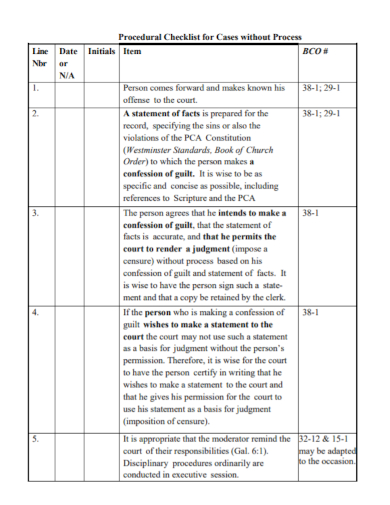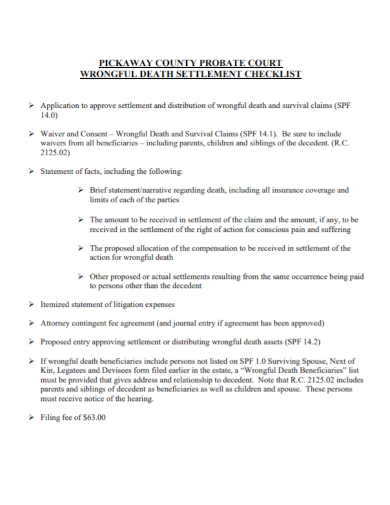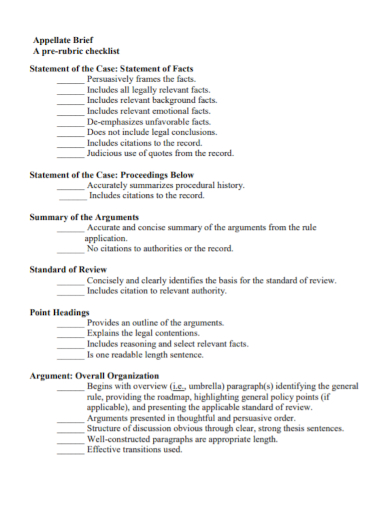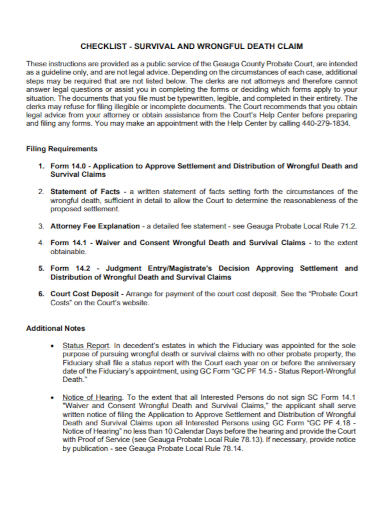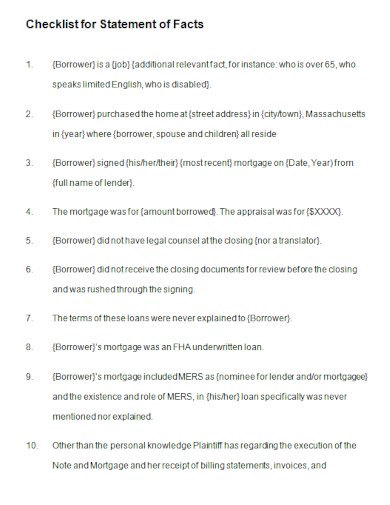6+ Statement of Facts Checklist Samples
If you are in a court trial or any legal procedure, you would need facts to support your claim(s). Facts are generally the details regarding the case that the client provides to his attorney. Before determining whether a lawsuit should be launched or finding a legal remedy to a specific situation, it is important to establish the facts of the case that are critical to the case’s result. Officially, this is termed as the statement of facts. If you are in need to organize your facts, look no further! In this article, we provide you with free and ready-to-use samples of Statement of Facts Checklists in PDF and DOC formats that you could use for your convenience. Keep on reading to find out more.
1. Statement of Facts Preparation Checklist
2. Statement of Facts Procedural Checklist
3. Statement of Facts Settlement Checklist
4. Statement of Reason Facts Checklist
5. Statement of Facts Case Checklist
6. Statement of Facts Death Claim Checklist
7. Checklist for Statement of Facts
What Is a Statement of Facts Checklist?
A statement of facts is a legal document that presents facts without equivocation. From appeals to completing car registration papers, these documents are utilized in a range of legal situations. The Statement of Facts contains critical background information that is required to follow the story of the current case. A checklist, on the other hand, is an organized list of all you should include for your statement of facts– sometimes in bulleted form. Because this checklist serves a single goal, it must be straightforward, to the point, short, and simple to grasp. To put it another way, you want to write a statement of facts that tells the court all they need to know about the case in a logical and clear manner. This document should convey this information in a compelling and convincing manner that benefits your party.
How to Make a Statement of Facts
In essence, this statement rationally lays out the facts and shows your or your client’s viewpoint in a professional manner. Rather than writing one from scratch, a statement of facts template could provide you with a framework so that you have a complete and convincing statement of facts to support all of your claims. You can choose one of our excellent templates listed above with this. Other than that, follow these steps below to guide you:
1. Begin with a simple rough draft.
Remember that this is a logical, professional paper, so start with the facts. For example, you should begin with the subject, date, and only include facts that will support the statement, proof that supports the facts, and a list of everyone engaged in the case and how they are related to it. Check out these items below:
- Dates
- The topic or subject
- Real-life facts
- Evidence to support the facts
- The names of people who were involved
- If at all feasible, signatures
2. Examine the case’s events and put them in chronological order.
Write this statement in a professional tone, ignoring your own ideas, and for the benefit of the other party. In this sort of paper, honesty and correctness are crucial, so double-check everything as you go. You want to make sure you make a compelling case for the side you’re supporting.
3. Pick the points you want to make.
Make sure you’re just using facts that are relevant to the case. Examine the circumstances and, if feasible, uncover the flaws in the opposing party’s case. In other words, both parties write assertions of fact, therefore you want yours to stand out and help you rather than the opposing side. You’re writing this to help yourself, to persuade the court to prefer your side of the tale based only on the facts and how they’re presented.
4. Proofread for errors.
After you’ve finished writing your document, look over it again to make sure there are no errors. Make any last adjustments and proofread the paper. You want your paper to be flawless in terms of language, spelling, and punctuation. If you are unsure about editing, try one of the many online grammar checkers or employ a professional proofreader/editor.
FAQ
What is an example of a statement of facts?
If you’re defending someone who was wounded in a vehicle accident, for example, your legal theory may be that the other driver was irresponsible, but your case theory might be that “he was in a hurry.” You emphasize facts that support your Theory of the Case in your Statement of Facts.
What do you mean by facts of the case?
Give a brief summary of the case’s facts. The “who, when, what, where, and why” of the case are the facts. Describe the case’s background, including the circumstances that led to the lawsuit, each party’s legal claims and defenses, and what transpired in the trial court.
How do you discover a case’s material facts?
To do so, go over the case and see how each fact influences the opinion’s holding and reasoning. If a fact has an impact on the conclusion or argument, it should be deemed relevant.
All in all, your statement of facts is crucial in your legal proceeding. It’s evidence to provide support to your claim. To help you get started with this, download our easily customizable and comprehensive samples of Statement of Facts Checklist today!
Related Posts
FREE 13+ Sample Expense Statement
FREE 12+ Sample Witness Statement
FREE 10+ Sample Cash Flow Analysis
FREE 9+ Master Professional Services Agreement Templates
FREE 8+ Counter Argument Samples
FREE 6+ Simple Income Statements
What is the General Format For SOP?
Essential Financial Statements for Your Business
How to Prepare an SOP Format?
What Is a Research Paper?
FREE 44+ Sample Statement Forms
FREE 12+ Control Checklist Samples
FREE 21+ Sample Profit and Loss
FREE 14+ Tally Sheet Samples
FREE 11+ Speech Writing Samples

